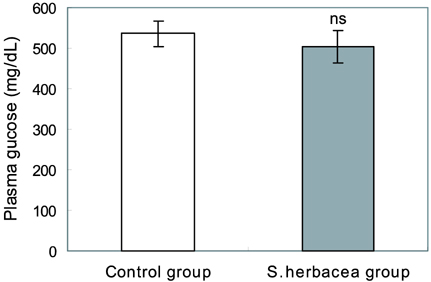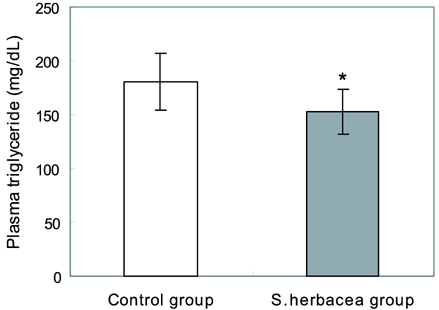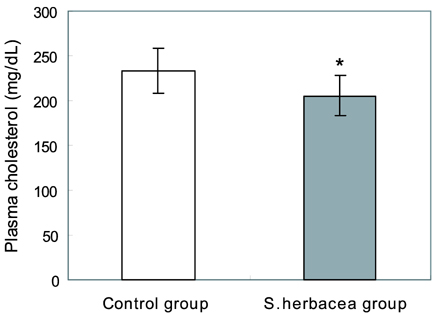Nutr Res Pract.
2007 Dec;1(4):371-375.
Hypolipidemic effect of Salicornia herbacea in animal model of type 2 diabetes mellitus
- Affiliations
-
- 1Biohealth Product Research Center, School of Food and Life Science, Institute for Food Sciences, Institute of Biomedical Engineering, Inje University, Gimhae, 621-749, Korea. fdsnkiji@inje.ac.kr
- 2Department of Genetic Engineering, Dong-A University, Busan, 604-714, Korea.
- 3Dicision of Ocean Science, Korea Maritime University, Busan, 606-791, Korea.
Abstract
- To control blood glucose level as close to normal is a major goal of treatment of diabetes mellitus. Hyperglycemia and hyperlipidemia are the major risk factors for cardiovascular complications, the major cause of immature death among the patients with type 2 diabetes. The purpose of this study is to determine the hypoglycemic and hypolipidemic effects of Salicornia herbacea in animal model of type 2 diabetes and to investigate the possible mechanisms for the beneficial effects of S. herbacea. S. herbacea was extracted with 70% ethanol and desalted with 100% ethanol. Three week-old db/db mice (C57BL/KsJ, n=16) were fed AIN-93G semipurified diet or diet containing 1% desalted ethanol extract of S. herbacea for 6 weeks after 1 week of adaptation. Fasting plasma glucose, triglyceride, and total cholesterol were measured by enzymatic methods and blood glycated hemoglobin (HbA1C) by the chromatographic method. Body weight and food intake of S. herbacea group were not significantly different from those of the control group. Fasting plasma glucose and blood glycated hemoglobin levels tended to be lowered by S. herbacea treatment. Consumption of S. herbacea extract significantly decreased plasma triglyceride and cholesterol levels (p<0.05). The inhibition of S. herbacea extract against yeast alpha-glucosidase was 31.9% of that of acarbose at the concentration of 0.5 mg/mL in vitro. The inhibitory activity of ethanol extract of S. herbacea against porcine pancreatic lipase was 59.0% of that of orlistat at the concentration of 0.25 mg/mL in vitro. Thus, these results suggest that S. herbacea could be effective in controlling hyperlipidemia by inhibition of pancreatic lipase in animal model of type 2 diabetes.
MeSH Terms
-
Acarbose
alpha-Glucosidases
Animals*
Blood Glucose
Body Weight
Chenopodiaceae*
Cholesterol
Diabetes Mellitus
Diabetes Mellitus, Type 2*
Diet
Eating
Ethanol
Fasting
Hemoglobin A, Glycosylated
Humans
Hyperglycemia
Hyperlipidemias
Lipase
Mice
Models, Animal*
Plasma
Risk Factors
Triglycerides
Yeasts
Acarbose
Blood Glucose
Cholesterol
Ethanol
Lipase
alpha-Glucosidases
Figure
Reference
-
1. American Diabetes Association. Management of dyslipidemia in adults with diabetes (Position Statement). Diabetes Care. 1999. 22:56–59.2. Bailey CJ, Day C. Traditional plant medicines as treatments for diabetes. Diabetes Care. 1989. 12:553–564.
Article3. Ballinger A, Peikin SR. Orlistat: its current status as an anti-obesity drug. Eur J Pharmacol. 2002. 440:109–117.
Article4. Bang MA, Kim HA, Cho YJ. Hypoglycemic and antioxidant effect of dietary hamcho powder in streptozotocin-induced diabetic rats. Journal of the Korean Society of Food Science and Nutrition. 2002. 31:840–846.
Article5. Bate KL, Jerums G. 3: Preventing complications of diabetes. Med J Aust. 2003. 179:498–503.
Article6. Bitou N, Ninomiya M, Tsujita T, Okuda H. Screening of lipase inhibitors from marine algae. Lipids. 1999. 34:441–445.
Article7. Centers for Disease Control and Prevention. Diabetes Surveillance Report. 1999. Atlanta, GA: US Department of Health and Human Services.8. Jang HS, Kim KR, Choi SW, Woo MH, Choi JH. Antioxidant and antithrombus activities of enzyme-treated Salicornia herbacea extracts. Ann Nutr Metab. 2007. 51:119–125.
Article9. Kaneto H, Nakatani Y, Kawamori D, Matsuoka TA, Matsuhisa M, Yamasaki Y. Role of oxidative stress, endoplasmic reticulum stress, and c-Jun N-terminal kinase in pancreatic β-cell dysfunction and insulin resistance. Int J Biochem Cell Biol. 2005. 37:1595–1608.
Article10. Kim HY. Effect of onion (Allium cepa) skin extract on pancreatic lipase and body weight-related parameters. Food Science Biotechnology. 2007c. 16:434–438.11. Kim KR, Jang MJ, Choi SW, Woo MH, Choi JH. Consumption of water extract of enzyme-treated S. herbacea powder showed hypocholestrolemic effect in rat fed high cholesterol diet. Journal of the Korean Society of Food Science and Nutrition. 2006. 35:55–60.
Article12. Kim MH. Effects of Salicornia herbacea L. supplementation on blood glucose and lipid metabolites in sterptozotocin-induced diabetic rats. Korean Journal of Nutrition. 2007a. 40:5–13.13. Kim MH. Effects of Salicornia herbacea L. supplementation on lipid peroxidation and mineral levels in streptozotocin-induced diabetic rats. Korean Journal of Nutrition. 2007b. 40:403–412.14. Kwon CS, Sohn HY, Kim SH, Kim JH, Son KH, Lee JS, Lim JK, Kim JS. Anti-obesity effect of Dioscorea nipponica Makino with lipase-inhibitory activity in rodents. Biosci Biotechnol Biochem. 2003. 67:1451–1456.
Article15. Lee HJ, Kim YA, Ahn JW, Lee BJ, Moon SG, Seo YW. Screening of peroxynitrite and DPPH radical scavenging activities from salt marsh plants. Korean Journal of Biotechnology and Bioengineering. 2004. 19:57–61.16. Lucas CP, Boldrin MN, Reaven GM. Effect of orlistat added to diet (30% of calories from fat) on plasma lipids, glucose, and insulin in obese patients with hypercholesterolemia. Am J Cardiol. 2003. 91:961–964.
Article17. Oh JH, Kim EO, Lee SK, Woo MH, Choi SW. Antioxidant activities of the ethanol extract of hamcho (Salicornia herbacea L.) cake prepared by enzymatic treatment. Food Science Biotechnology. 2007. 16:90–98.18. Park SH, Ko SK, Choi JG, Chung SH. Salicornia herbacea prevents high fat diet-induced hyperglycemia and hyperlipidemia in ICR mice. Arch Pharm Res. 2006. 29:256–264.
Article19. UK Prospective Diabetes Study (UKPDS) Group. Tight blood pressure control and risk of macrovascular and microvascular complications in type 2 diabetes. UKPDS 38. BMJ. 1998. 317:703–713.20. Watanabe J, Kawabata J, Kurihara H, Niki R. Isolation and identification of α-glucosidase inhibitors from Tochu-cha (Encommia ulmoides). Biosci Biotechnol Biochem. 1997. 61:177–178.
Article
- Full Text Links
- Actions
-
Cited
- CITED
-
- Close
- Share
- Similar articles
-
- Anti-obesity effect of Korean Hamcho (Salicornia herbacea L.) powder on high-fat diet-induced obese rats
- Effects of Salicornia herbacea L. Supplementation on Lipid Peroxidation and Mineral Levels in Streptozotocin-Induced Diabetic Rats
- Effects of Salicornia Herbacea L. Supplementation on Antioxidative Enzyme Activities in Streptozotocin-Induced Diabetic Rats
- Effects of Salicornia herbacea L. Supplementation on Blood Glucose and Lipid Metabolites in Streptozotocin-Induced Diabetic Rats
- Activation of Macrophage by Polysaccharide Isolated from Salicornia herbacea L.





